
Joan M. Brehm, Professor and Co-Director, Center for a Sustainable Water Future, Illinois State University, Bill Stewart, Professor, Department of Recreation, Sport, and Tourism, University of Illinois, Cory Suski, Professor, Department of Natural Resources and Environmental Sciences, University of Illinois, Maria Librada Chu, Associate Professor, Department of Agricultural and Biological Engineering, University of Illinois, Jordan Buffington, Graduate Research Assistant, Illinois State University
Current research suggests that low order streams are surprisingly rich in biodiversity but are also predicted to be the most fragile and least resilient to future climate change regimes. This pilot study focused on the protection of vital headwater streams in agricultural landscapes to mitigate the negative impacts from rising temperatures and increase the productivity of these waterways that are critical to native fish biodiversity. More specifically, this study utilized a place-based examination of select low order streams and associated landowners in the Lake Shelbyville/Kaskaskia River reach of the Upper Kaskaskia River Watershed. With the collaboration of the Shelby County Farm Bureau, key landowners were identified that own land with low order streams vulnerable to biodiversity loss due to climate change. A total of 8 key informant interviews were conducted with landowners to inform a more in-depth understanding of how they view these streams, their identity as a “good farmer”, and how they view/willingness to engage in conservation practices that extend beyond water quality protection to include promotion of biodiversity in the critical low order streams. Key findings indicated that farmers viewed conservation as simply part of a farmer’s responsibility, especially for land that they owned. However, most of the projects were focused on adjacent lands and not the creek directly, with an emphasis on nutrient reduction and terrestrial habitat. The lack of focus on in-stream practices was attributed to two issues: (1) lack of support/funding to encourage stream protection, and (2) community-based norms of a “good farmer” regarding what a clean farm landscape should look like.

